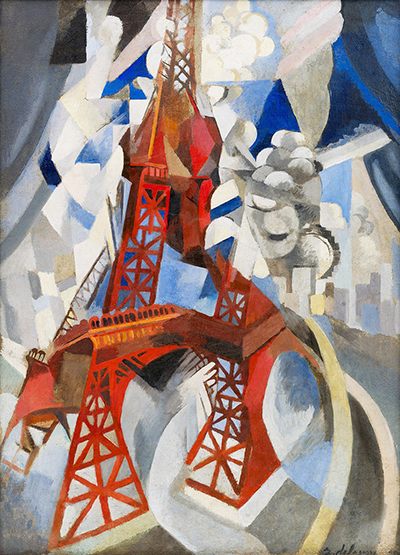For all that he achieved across his career, Robert Delaunay remains most famous for his series of depictions of the Eiffel Tower in Paris.
Introduction to the Eiffel Tower Series
The artist appreciated both the symbolic value of this iconic tower, but also its aesthetic beauty. Soon after painting his first iteration in 1909 he would decide to continue on this theme for the next few years. After 1912 he took a break to spread his interest elsewhere, but then returned to this topic in the 1920s, in which he again re-invented the genre of architectural painting.
His work is famous for its use of the iconic symbol of the Eiffel Tower, with many aware of this series, without necessarily knowing much about the rest of Delaunay's career. His legacy was protected through the work of his wife, Sonia, who continued to impress for a number of years after his death and produced a highly impressive and innovative body of work herself.
Description
Whilst elements of this painting, La Tour Rouge, may not initially be clear, because of the style of the work, we can consult Delaunay's previous iterations on this theme in order to decipher the content. His earlier versions are less abstract, and show two vertical structures on either side of the tower, representing other high rise buildings in Paris.
The artist then fills the background with a blue sky and white fluffy clouds, though this version fragments everything, in a Cubist manner. The tower itself is pictured in red, with its angles rotated and contorted, though still just about recognisable. A version from around the same time, Champs de Mars: The Red Tower, handles the tower in a similar manner but gives a much clearer definition of detail to the surrounding buildings.
The influence of Paul Cezanne is clear in artworks such as this, where angles are played around with, and items that we recognise are presented in an unusual, complex manner. We could essentially view the same thing from different angles, all within the same painting, and this made Cubism a short-lived, but highly influential period in European art.
Evolution as an Artist
Delaunay would slowly move towards a greater and greater use of abstraction in his work. Eventually, his forms would become unidentifiable, reduced to simple arrangements of squares and circles, as his development had finished. After his death, his wife Sonia would continue to work innovatively, adding new ideas to their body of work, and it was clear that Robert himself still had many new avenues to explore were he to have lived a little longer.
Painting Details
The painting pictured at the top of the page is known as La Tour Rouge, or Red Eiffel Tower and dates to 1911-12. It is a part of the Guggenheim Museum, who own a number of Robert Delaunay's paintings. This would be one of the last of his first phase of Eiffel Tower paintings, before returning to the topic in 1922.
Conclusion
La Tour Rouge represents a mid-point in Robert Delaunay's series of Eiffel Tower paintings, as he continues to experiment with different levels of abstraction. Perhaps they are a summary of his career as a whole, as he fuses different contemporary ideas together over time, regularly experimenting with different balances. There is also the specific use of colour, which was a key element to his work.




